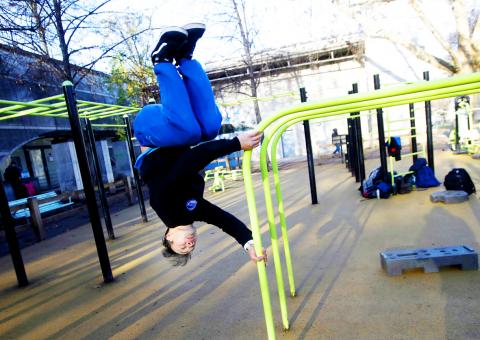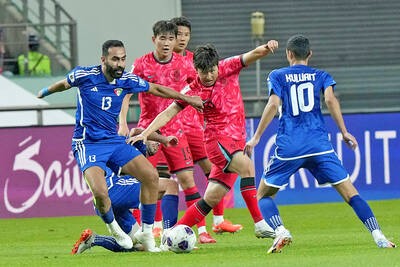Their test of skill and courage was as dangerous as it was effective: Having clambered as stylishly as they could to the summit of a jagged, pyramid-shaped climbing wall in the suburbs of Paris, the young men would hang each other upside down by the feet from the top.
One slip and the four-story drop could have killed them.
Chau Belle flashes a grin at the memory of those heady days in the 1990s, when he and his gang of friends and cousins pushed each other and pushed the envelope of what has since mushroomed into a globalized street sport of urban acrobatics known as parkour.

Photo: AP
The sport is talked about as a possible new Olympic discipline, but is also the focus of a heated custody battle as its popularity and marketing potential grow.
Parkour, derived from the French word for path or journey, was still just an exploration of self when Belle and his friends were dangling each other off the 17m-tall Dame du Lac.
“It was a form of courage. A bit crazy, too. You really had to trust the person who held you,” the 41-year-old said. “It was a test. A test of self-belief. Of one’s friends. Of family. Of ourselves, too.”
Parkour was built around the simple philosophy that almost any terrain can be turned into a playground for running, jumping, climbing and pushing oneself.
Male practitioners call themselves traceurs; women are traceuses. Both roughly translate as pathfinder.
A milestone in parkour’s growth was injecting the adrenaline jolt into Daniel Craig’s opening scenes as James Bond, with the actor haring through a construction site in Casino Royale in pursuit of a terrorist with Spiderman skills, played by Sebastien Foucan.
Foucan was one of the founding practitioners of parkour, along with Belle, his cousin David Belle and a half-dozen others. They called themselves “the Yamakasi” and the sport they were inventing “the art of movement.”
“People see only what’s in front of them, at their feet. We succeeded in telling ourselves to look upwards, to say: ‘There are things we can do with this,”’ Belle said. “We’d do the same exercise 10,000, 20,000, 30,000, 40,000 times.”
Parkour spread in part because its practitioners’ derring-do videos of gravity-defying flips, jumps and other exploits work in any language and readily generate social media clicks.
However, the sport’s coming-of-age has also attracted a powerful suitor, one unwelcomed by many in parkour: gymnastics.
Using its financial muscle and clout within the Olympic movement, the Federation Internationale de Gymnastique (FIG) is steadily bringing — critics say forcing — parkour under its wing.
This month, a FIG Congress recognized parkour as gymnastics’ newest discipline. FIG is now organizing introduction-to-parkour coaching courses, scheduling its first world championships for parkour in 2020 and intends to lobby the International Olympic Committee for parkour’s inclusion in the 2024 Olympic Games in Paris.
All this despite a #WeAreNOTGymnastics protest by parkour lovers on social media and howls of complaint from parkour groups.
“This is the equivalent of a hostile takeover,” says Eugene Minogue, CEO of Parkour Earth, the grouping formed last year from six national associations that is one of FIG’s most vocal critics, but is struggling to defend itself against the 137-year-old federation.
“They are completely whitewashing our sport, its integrity, its history, its lineage, its authenticity,” Minogue said.
FIG wants to get its hands on parkour’s young and growing fan base to stay relevant with Olympic leaders who want action sports that appeal to 21st-century audiences and sponsors, Minogue said.
Other long-established sports have done likewise: Cycling, for example, absorbed BMX in the 1990s and skiing became the international federation for snowboarding.
“They want to codify it, they want to monetize it,” Minogue said of FIG. “It’s about money, about influence, about power, about control. It’s about having a seat at the table.”
Another concern is that FIG-organized competitions could denature parkour’s “let’s play” philosophy and endanger parkour athletes by encouraging them to try overly dangerous, crowd and judge-pleasing tricks.
“The one thing I hope is that gymnastics does not condone risk-taking and that it doesn’t glorify an elite, because we’ve been fighting for 20 years against young people chasing clicks, filming themselves doing acrobatics and taking risks with the aim of becoming famous and finding a sponsor,” said Sacha Lemaire, president of the France-based Federation de Parkour.
FIG says that parkour and gymnastics are far more of a natural fit than its critics acknowledge.
As an example of how the sports can coexist, it points to Sweden, where parkour joined the gym federation in 2014 and where traceurs and traceuses often train in gymnastic facilities to avoid the cold.
In response to e-mailed questions, FIG secretary-general Andre Gueisbuhler said its competitions would not reward risk, would not be “about jumping furthest and highest,” and would help make parkour safer.
FIG “offers an infrastructure which has all necessary means to develop the sport worldwide within a short time,” Gueisbuhler wrote.
Belle, who teaches what he still calls the art of movement, said he struggles to see convincing parallels between the activity dreamed up by the Yamakasi and what he regards as the rigid world of gymnastics.
“Parkour has become a merchandise now,” he said. “At the beginning, it was free.”

Brazil has four teams, more than any other country, in the expanded Club World Cup that kicked off yesterday in the US, but for SE Palmeiras, the competition holds a special meaning: winning it would provide some redemption. Under coach Abel Ferreira since 2020, Palmeiras lifted two Copa Libertadores titles, plus Brazilian league, cup and state championships. Even before Ferreira, it boasted another South American crown and 11 league titles. The only major trophy missing is a world champions’ title. Other Brazilian clubs like Fluminense FC and Botafogo FR, also in the tournament, have never won it either, but the problem for Palmeiras

Paris Saint-Germain’s Lee Kang-in has pleaded with South Korea fans to get behind the team at the 2026 FIFA World Cup after more boos were aimed at coach Hong Myung-bo despite leading them to qualification. South Korea reached next year’s finals in North America without losing a game, but that does not tell the whole story. The country’s soccer association has been in the firing line, having scrambled about to find a successor after sacking the unpopular Jurgen Klinsmann in February last year. They eventually settled on Hong, the decorated former skipper who had an unsuccessful stint as coach in 2013-2014, during which

Lionel Messi drew vast crowds and showed flashes of his brilliance when his Inter Miami side were held to a goalless draw by African giants Al-Ahly as the revamped FIFA Club World Cup got off to a festive start on Saturday. Fans showed up en masse for the Group A clash at the Hard Rock Stadium, home to the NFL’s Miami Dolphins, but Messi could not fully deliver, his best chance coming through a last-second attempt that was deflected onto the crossbar. Inter Miami next face FC Porto on Thursday in Atlanta, while Al-Ahly, who benefited from raucous, massive support, are to

Ferrari’s F1 fortunes might be flagging, but the Italian team start this weekend’s 24 Hours of Le Mans as favorites, targeting a third consecutive triumph in motorsport’s fabled endurance classic. Roger Federer is acting as celebrity starter with the tennis icon getting the 93rd edition of the jewel in four-wheeled endurance racing’s crown under way tomorrow. Twenty-four hours later, through daylight, darkness and dawn, the 21 elite hypercars are to battle it out over 300 laps (more than 4,000km) in front of a sold-out 320,000 crowd burning the midnight oil with copious quantities of coffee and beer. Ferrari made a triumphant return after